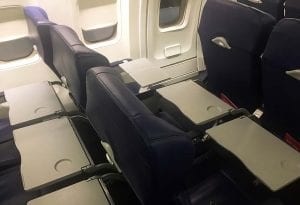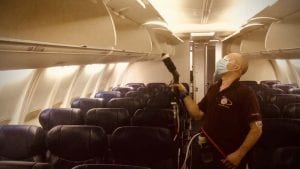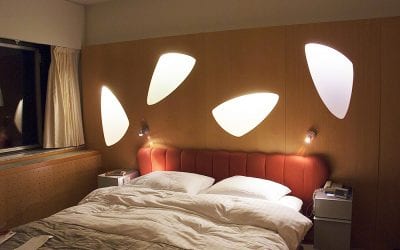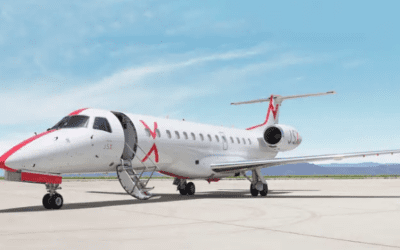With today’s disinfectant protocols and air recirculation, planes are some of the safest places to be
In a conversation with Stuart Huddart, the Executive Director of Operations for National Aviation Services, I learned how clean aircraft are today. Of the servicing company’s more than 1,000 employees, only three have gotten sick during the coronavirus emergency period (and their illness was traced to non-workplace infestations). During that time he and his crews were at work every night cleaning and disinfecting planes. Though they were dealing with closed environments where COVID-19 is expected to spread, he and his crews were spared.
Southwest Airlines arranged for me to watch the overnight cleaning and the deep cleaning of planes at Baltimore Washington International Airport (BWI). There, I saw first hand what many of us are seeing on video and advertisements designed to encourage passengers to fly again. Electrostatic sprayers with misty disinfectants play a big part in keeping passengers safe.
However, basic hard work has to be done from the cockpit to the rear galleys before anyone can wander up and down the aisle with the new electrostatic spray guns.
The grunt work that keeps planes clean hasn’t changed that much, except at the very end of the process

Southwest plane ready for electrostatic cleaning. ©Leocha
Plane interiors are still cleaned by hand. The electronic wizardry of electrostatic guns sprays disinfectant later. The disinfectants are applied on aircraft after the basic cleaning and scrubbing are done. For planes going through a “remain overnight” cleaning this means that disinfectant is sprayed by cleaners on all touchpoints. That means every aircraft in Southwest’s fleet is cleaned with EPA-approved disinfectant every night.
Workers spray and then wipe down every handle and seat belt buckle. The seatback tray tables are all cleaned by hand. The armrests are sprayed with disinfectant and then wiped down. Next, each cleaner working the seating area of the plane reaches up and disinfects any light switches, flight attendant call buttons, and air vents. Toilets are also carefully disinfected and galleys are washed. And, seatback pockets are emptied of any trash that has been left aboard the aircraft.
This “remain overnight” cleaning is plain hard work. It is basic manual labor. Plus, with today’s disinfectants, the need for personal protective equipment and goggles are not really necessary. However, many of the disinfectants are toxic and require care to apply.
The electrostatic spraying is used for the “deep cleaning process” final step
During the next phase of the cleaning, the deep cleaning, crews go through the same process as all overnight planes. But, now the plane is meticulously cleaned. Air vents where clean airconditioned air enters the plane are cleaned. The almost-invisible gratings that hide the intake of cabin air are cleaned. Here, crew members must crawl between seats and work with special swabs to clean the grating where dirt and dust collect. The seat stands that hold every seat are cleaned by hand. These are not simple stanchions but curled pieces of metal that serve to provide a bit of give-and-take as the plane soars, hits turbulence, and lands.

The electrostatic cleaning process on Southwest as part of their Deep Cleaning servicing. ©Leocha
All of the seat cushions are removed. Beneath these cushions workers carefully vacuum crumbs and dirt. Every tray table is lowered and cleared. The toilets are scrubbed with special sponges and cloths. In the galley area, every drawer is pulled out and wiped clean with a food service approved cleaner. Then the storage drawers are put back in place and locked shut.
Finally, the electrostatic sprayer is plugged in, loaded with disinfectant, and rolled to the back of the plane. Every inch of the plane is covered with a coating of disinfectant. The Southwest process starts with spraying the toilets. Then workers spray the galley areas. Then cabin doors and the overhead luggage compartments. Next, the workers spray every seat, between every seat, under every seat. The electrostatic operator then attacks the tray tables and the lighting fixtures with their collections of controls and switches.
Finally, Southwest Airlines applies an extra antimicrobial agent to the entire plane
This is almost a Southwest exclusive among the planes that I saw being cleaned. Also, in conversations with local workers and cleaning crews, I learned that the antimicrobial cleaner is not a normal part of other airline cleaning operations. It takes about ten minutes to change over the electrostatic sprayer to handle the antimicrobial agent. This agent provides 30 days of additional coronavirus-killing protection.
The disinfectant that has just been sprayed dries during the ten-minute changeover. The equipment is switched to spray the interior of the plane with the antimicrobial agent that kills the coronavirus for 30 days after its application. This extra antimicrobial agent step that Southwest takes adds another long-term layer of antivirus protection.
READ ALSO ON TRAVELERS UNITED BLOG:
I need more than a mask to save me from COVID-19 on planes
Why flight crews should all be coronavirus tested
Finally, the cockpit is cleaned separately
Most airlines use a combination of four different cleaners and disinfectants for their total cleaning operations. The main cabin is sprayed with the disinfectant. The galleys are cleaned with another solvent approved for use in food-service operations. The final antimicrobial agent is layered onto the freshly disinfected cabin. And finally, the cockpit is cleaned by hand. Many of today’s disinfectants have a corrosive nature that makes the glass-and-plastic-covered avionics difficult to read.
Plus, pilots are interested in having a cleaning crew spend as little time as possible in what they consider their world. Boeing and Airbus both have specific cleaners approved that can be used on the flight deck.
In the past, aircraft were never totally disinfected as they are today
The deep-cleaning process is manual until the final spraying of the disinfectant. The amount of pure physical labor is daunting. However, it is the final spraying with a disinfectant that kills the coronaviruses that have spread across the planet. Then Southwest adds another long-term layer of protection for a different 30-day protection coating.
Air is recirculated and passed through hospital filters to stay clean during a flight. The air in a plane cabin is exchanged totally every two to three minutes and is far less polluted than that found in most city offices. So, between the antivirus disinfectants and the hospital-grade air filters and exchange, aircraft interiors have never been cleaner.
These steps are all being taken with the goal of making passengers feel confident that if they get on a plane without a virus, they will depart as a healthy passenger. Passengers wear masks for social distancing. They receive or bring disinfecting towelettes to take control of their space. And hospital filters clean aircraft air.

Charlie Leocha is the President of Travelers United. He has been working in Washington, DC, for the past 14 years with Congress, the Department of Transportation, and industry stakeholders on travel issues. He was the first consumer representative to the Advisory Committee for Aviation Consumer Protections appointed by the Secretary of Transportation from 2012 through 2018.



